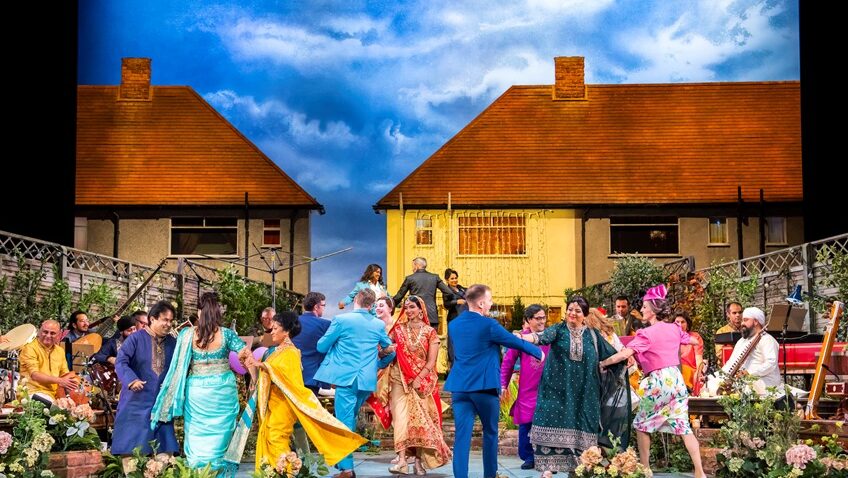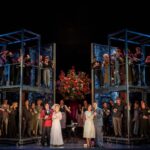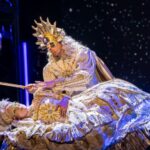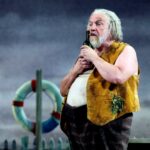Ambitious musical innovation is always a thrilling prospect. Monteverdi was so keen on it that, in the early 1600s, he came up with Orfeo in a new, experimental art form that combined words and drama with dance, music and song. It’s become the earliest major opera we still enjoy today.
Now, in a colossal twenty-first century collaboration between baroque specialist/harpsichordist MD Laurence Cummings of Opera North and composer/sitarist MD Jasdeep Singh Degun of South Asian Arts UK, Monteverdi’s work has taken on further fascinating musical innovation. The western styles of this early European Baroque opera are now blended together with full-on classical Indian music, played on Indian instruments and sung in Indian singing styles. The Beatles created unique and magical music with some such combinations, of course, but not on this scale! This elaborate fusion alternates, combines and intertwines the two styles of music and singing big-scale. Furthermore, the opera is sung in a range of different sub-continent languages as well as Italian, all with compact subtitles, and it also features newly composed music from Jasdeep Singh Degun.
The simple story tells of brilliant musician Orpheus: right after he marries his beloved Eurydice, she promptly dies, bitten by a snake; he’s so grief-stricken he travels to the Underworld to persuade the gods Pluto and Proserpina to allow her back to life. Their proviso is that he doesn’t look back at her for even a split second on the journey back. But lo and behold and whoops, he does. That being almost the entire story it’s not surprising a performance of almost three hours will be pretty static a good deal of the time. Music, set and goings-on, then, need to be pretty special!
This same mythical tale involving gods, goddesses, human love, loss and grief and the role of Nature is one we have in common with South Asian culture. In common, too, are music that enjoys frilly ornamentation, stylised gestures and the conveying of emotion in music and song. Now add an inter-racial marriage between European Orpheus and his lovely Asian Eurydice and immediately the onstage wedding celebrations are gloriously peopled by friends, relations and musicians from two different cultures, side by side, eagerly interacting and learning from one another.
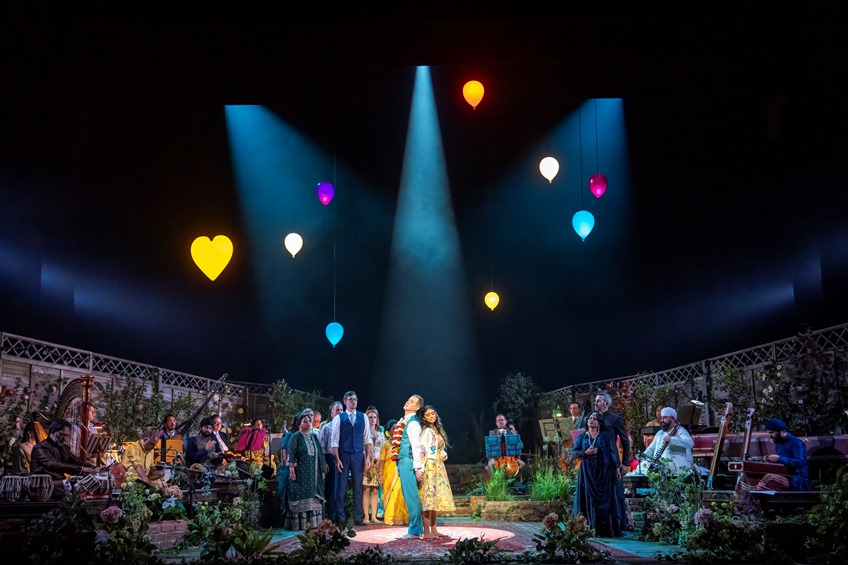
Leslie Travers’ beautiful, colourful set creates breathtaking perspective, completely filling the stage and displaying nigh on twenty musicians and their instruments to spectacular effect as they sit amongst plants, flowers and fairy-lights and along trellised fences in the glorious, candlelit back garden of a semi-detached house. Western suits and wedding frocks dance side by side with sumptuous, colour-drenched, bejewelled Indian fabrics and traditional outfits, while impressively active skies and clouds behind the festivities change with the passage of time, events and mood.
The breathtaking spectacle of the onstage players and their playing stuns at the outset and brings fascinating interest throughout, the Western players seated on chairs, using music scores, the virtuoso Indian players of sitar, theorbo, tabla etc largely seated on the floor and playing without written music. Instead, they maintain a great awareness and appreciation of one another and of the singers as their music imitates, echoes, interacts, contrasts or rivals each others’ contributions in a more improvised way. Together or in turn, stringed instruments and highly talented players from East and West create a joyous, effortless blend of delightful sounds and tones as harp, harpsichords and sitar are plucked, the santoor delicately hammered, and violins, cello, viola and tar shehnai bowed. The drums and rhythmic percussion likewise complement one another and marry well, while the trumpet’s striking clarion calls feature just at the start of each act.
To many the sound of mesmerising Indian instruments is all part of the world of yoga, meditation and relaxation: indeed, at least four people on one row of the audience alone admitted their eyes inadvertently closed at some point – and maybe some of the instrumentals (and songs) are a tad over-long for some.
When it comes to the very different singing styles of the two cultures it’s a harder task to have them blend as naturally and easily as can be achieved by the instruments since the contrast in styles and sounds is more stark. While the European operatic style gives full, rounded projection and resonance to the voice and follows precise notes, the Asian voices are not projected, and the ragas are more open to improvisation as they characteristically bend and float and rapidly twist and turn up and down, their patterns frequently imitated by the instruments, with occasional sequences sounding like a less clipped western jazz skat form. The two styles mainly work in alternating contrast but they also combine in moving duets as when Charon or Caronte (Kaviraj Singh) the boatman repeatedly refuses to allow Orpheus (Nicholas Watts) into the Underworld, or when Orpheus sings with Apollo (Kirpal Singh Panesar) or Proserpina (Chandra Chakraborty) with Pluto (Dean Robinson). A delightfully moving solo, too, comes from Yarlinie Thanabalasingam as Hope aka Nambikkai.
This exciting, ambitiously broad re-imagining of Orfeo is full of fascination, spectacle, beauty and touching, gentle magic as well as being a glorious feast of music for both eye and ear.
Eileen Caiger Gray
Orpheus will tour to Newcastle, Nottingham and Salford and will be available for streaming on the OperaVision platform from Oct 31 until April 30 2023.

